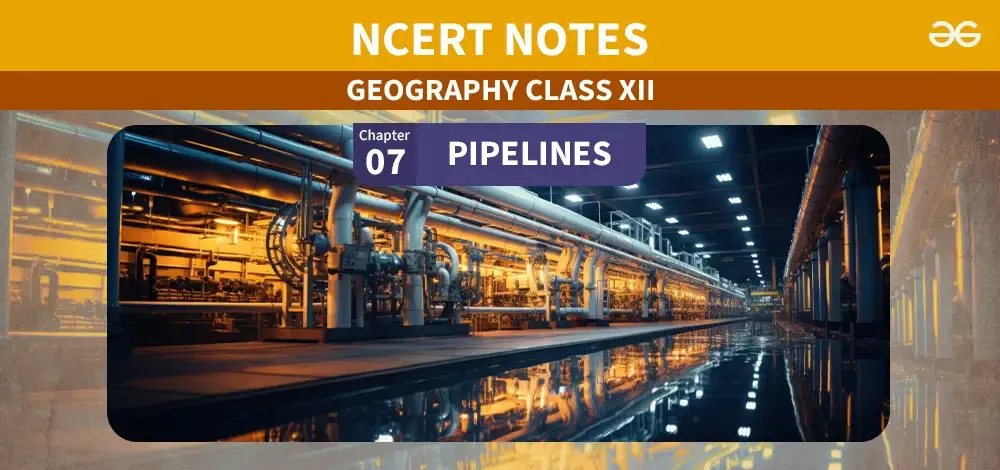Class 12 Geography Notes Chapter 7 Pipelines
Last Updated :
24 Apr, 2024
Pipelines serve as vital conduits for transporting liquids and gases, including water, petroleum, and natural gas, ensuring a continuous flow from production sources to consumption points. This article delves into the significance and various applications of pipelines, showcasing their indispensable role in modern infrastructure.

Class 12 Geography Notes Chapter 7 Pipelines
Applications of Pipelines
The application of pipelines are as follows:
Water Transportation
Pipelines are ubiquitous in supplying water, a fundamental necessity, to residential, commercial, and industrial areas. Their widespread use ensures efficient water distribution, mitigating the challenges posed by traditional transportation methods such as tanker trucks or canals.
Petroleum Transport
In regions like the United States, pipelines form a dense network facilitating the movement of petroleum from extraction sites to refineries and ultimately to consumers. Notably, the Big Inch pipeline stands out as a prominent example, linking the Gulf of Mexico’s oil wells to the northeastern states, underscoring the pivotal role pipelines play in the country’s energy infrastructure.
Natural Gas Conduits
Cooking gas, or liquefied petroleum gas (LPG), is increasingly supplied via pipelines in numerous regions worldwide, offering a safer and more convenient alternative to traditional delivery methods. The adoption of pipelines for natural gas transport enhances reliability and minimizes environmental risks associated with other modes of transportation.
Innovative Uses: Liquidified Coal and Milk Transportation
Pipelines exhibit versatility beyond conventional applications, as exemplified by the transport of liquidified coal in certain areas. Moreover, innovative initiatives such as the use of pipelines to transport milk from farms to factories in New Zealand underscore the adaptability of this mode of transportation across diverse industries.
Global Pipeline Networks
North America: Oil Pipeline Infrastructure
The United States boasts an extensive network of oil pipelines, facilitating the seamless movement of crude oil from production regions to consumption centers. The prevalence of pipelines underscores their efficiency and cost-effectiveness compared to alternative modes of transportation, contributing significantly to the nation’s energy security and economic prosperity.
Eurasia: Connecting Oil Wells to Markets
Across Europe, Russia, West Asia, and India, pipelines serve as vital links connecting oil extraction sites to refineries, ports, and domestic markets. The strategic expansion of pipeline networks in regions like Turkmenistan underscores their pivotal role in bolstering energy security and facilitating economic development through efficient resource utilization.
Longest Proposed Pipeline: Iran-India via Pakistan
The proposed international oil and natural gas pipeline traversing Iran, India, and Pakistan stands as a testament to the growing significance of pipeline infrastructure on a global scale. Once completed, this ambitious project will set a new benchmark as the longest pipeline in the world, underscoring the pivotal role of pipelines in fostering regional cooperation and enhancing energy access.
Conclusion
Pipelines represent indispensable infrastructure assets, facilitating the efficient and reliable transport of liquids and gases across various sectors and geographical regions. From water supply to petroleum and natural gas transport, pipelines play a pivotal role in ensuring uninterrupted flows, driving economic development, and enhancing energy security on a global scale. As nations continue to invest in expanding and modernizing pipeline networks, the significance of this mode of transportation is poised to grow, underpinning sustainable development and meeting evolving energy needs in the 21st century.
Class 12 Geography Notes Chapter 7 Pipelines
What are the primary advantages of using pipelines for transporting liquids and gases?
Pipelines offer several benefits, including cost-effectiveness, reliability, and safety. They provide uninterrupted flow, reducing the need for manual handling and minimizing the risk of spills or accidents associated with alternative transportation methods.
How extensive is the global pipeline network, and which regions rely heavily on pipeline infrastructure?
The global pipeline network spans vast geographical regions, with significant usage observed in North America, Europe, Eurasia (including Russia and West Asia), and India. These regions heavily rely on pipelines to transport commodities such as oil, natural gas, and water, contributing to their energy security and economic development.
What innovative applications of pipelines are emerging beyond conventional uses such as oil and gas transport?
Pipelines are increasingly being utilized for diverse applications, including the transportation of liquidified coal and even perishable goods like milk. Such innovative uses highlight the adaptability and versatility of pipelines across various industries, facilitating efficient logistics and supply chain management.
What are some notable examples of large-scale pipeline projects, and how do they contribute to regional cooperation and economic development?
Projects like the proposed Iran-India via Pakistan international oil and natural gas pipeline exemplify ambitious endeavors aimed at enhancing energy access and fostering regional cooperation. These projects not only bolster economic ties between nations but also stimulate infrastructure development and promote energy security on a global scale.
How do pipelines compare to other modes of transportation, such as rail or maritime shipping, in terms of efficiency and environmental impact?
Pipelines generally offer higher efficiency and lower environmental impact compared to alternative transportation modes like rail or maritime shipping. They minimize energy consumption, reduce greenhouse gas emissions, and mitigate the risk of accidents or spills, making them an environmentally sustainable choice for long-distance transport of liquids and gases.
Share your thoughts in the comments
Please Login to comment...